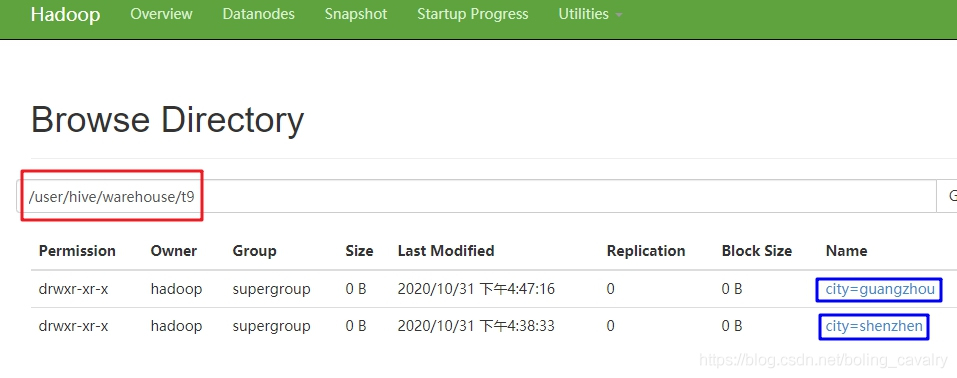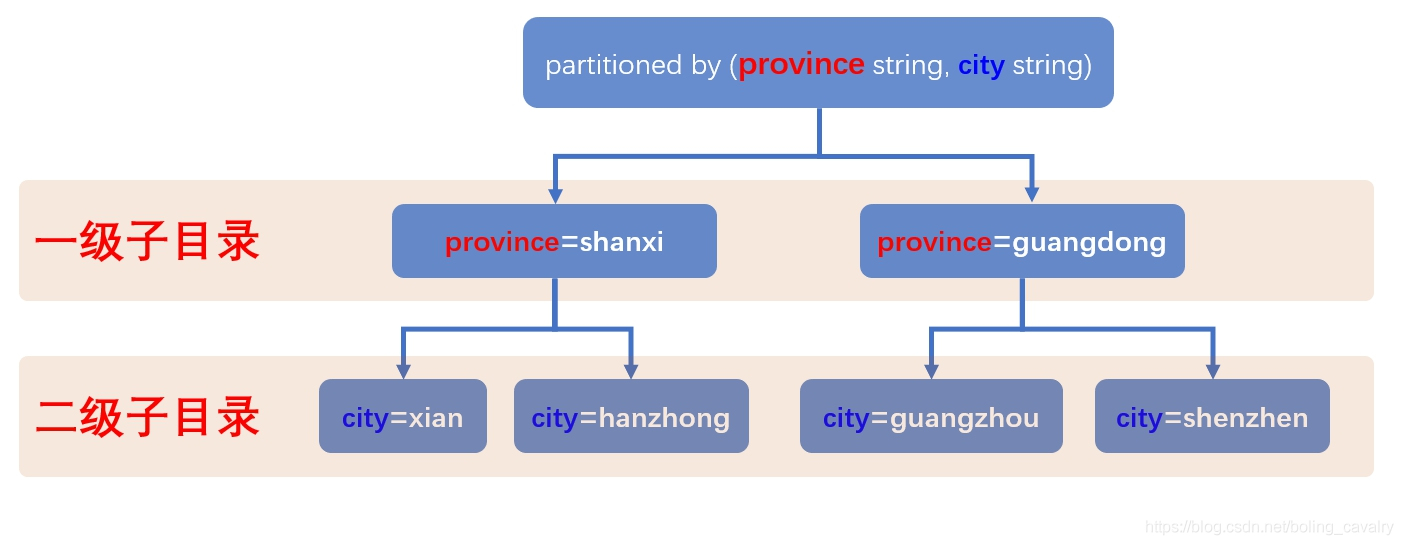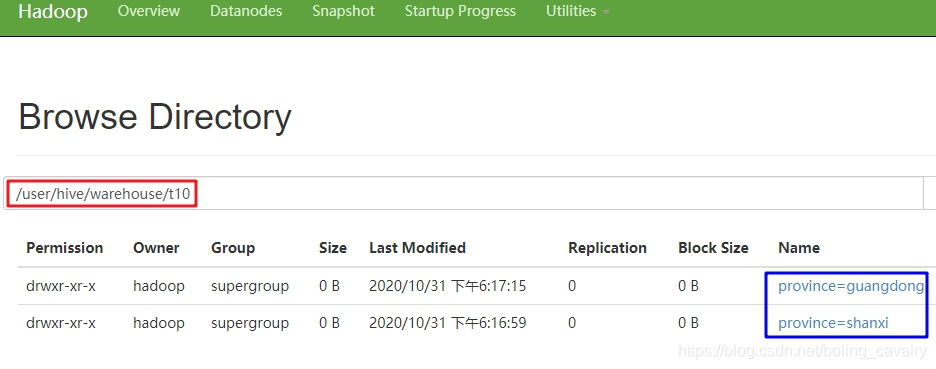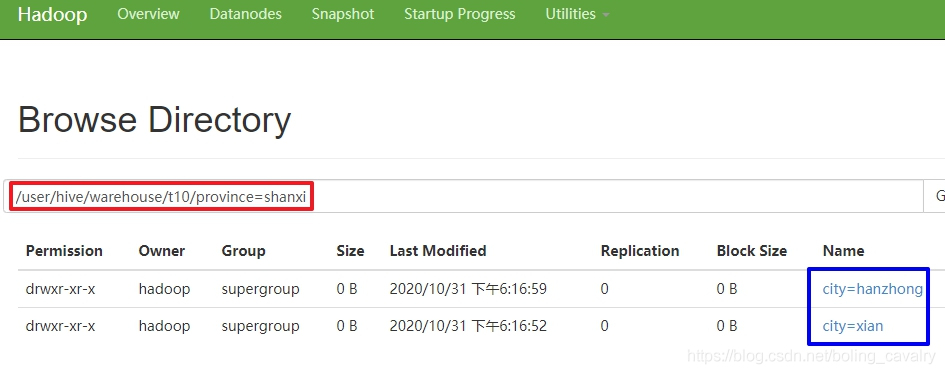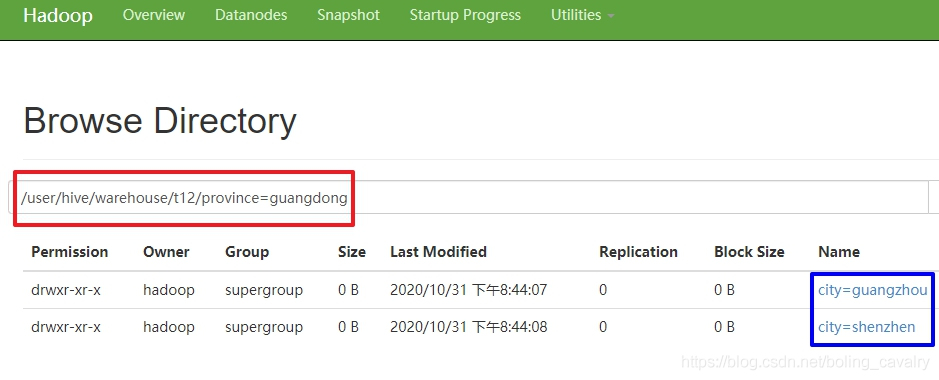欢迎访问我的GitHub
github.com/zq2599/blog_demos
内容:所有原创文章分类汇总及配套源码,涉及Java、Docker、Kubernetes、DevOPS等;
本篇概览
本文是《hive学习笔记》系列的第四篇,要学习的是hive的分区表,简单来说hive的分区就是创建层级目录的一种方式,处于同一分区的记录其实就是数据在同一个子目录下,分区一共有两种:静态和动态,接下来逐一尝试;
静态分区(单字段分区)
先尝试用单个字段分区,t9表有三个字段:名称city、年龄age、城市city,以城市作为分区字段:
- 建表:
create table t9 (name string, age int)
partitioned by (city string)
row format delimited
fields terminated by ',';
- 查看:
hive> desc t9;
OK
name string
age int
city string
# Partition Information
# col_name data_type comment
city string
Time taken: 0.159 seconds, Fetched: 8 row(s)
- 创建名为009.txt的文本文件,内容如下,可见每行只有name和age两个字段,用来分区的city字段不在这里设置,而是在执行导入命令的时候设置,稍后就会见到:
tom,11
jerry,12
- 导入数据的命令如下,可见导入命令中制定了city字段,也就是说一次导入的所有数据,city字段值都是同一个:
load data
local inpath '/home/hadoop/temp/202010/25/009.txt'
into table t9
partition(city='shenzhen');
- 再执行一次导入操作,命令如下,city的值从前面的shenzhen改为guangzhou:
load data
local inpath '/home/hadoop/temp/202010/25/009.txt'
into table t9
partition(city='guangzhou');
- 查询数据,可见一共四条数据,city共有两个值:
hive> select * from t9;
OK
t9.name t9.age t9.city
tom 11 guangzhou
jerry 12 guangzhou
tom 11 shenzhen
jerry 12 shenzhen
Time taken: 0.104 seconds, Fetched: 4 row(s)
- 前面曾提到分区实际上是不同的子目录,来看一下是不是如此,如下图,红框是t9的文件目录,下面有两个子目录city=guangzhou和city=shenzhen:
- 查看子目录里面文件的内容,可见每条记录只有name和age两个字段:
[hadoop@node0 bin]$ ./hadoop fs -ls /user/hive/warehouse/t9/city=guangzhou
Found 1 items
-rwxr-xr-x 3 hadoop supergroup 16 2020-10-31 16:47 /user/hive/warehouse/t9/city=guangzhou/009.txt
[hadoop@node0 bin]$ ./hadoop fs -cat /user/hive/warehouse/t9/city=guangzhou/009.txt
tom,11
jerry,12
[hadoop@node0 bin]$
以上就是以单个字段做静态分区的实践,接下来尝试多字段分区;
静态分区(多字段分区)
- 新建名为t10的表,有两个分区字段:province和city,建表语句:
create table t10 (name string, age int)
partitioned by (province string, city string)
row format delimited
fields terminated by ',';
- 上述建表语句中,分区字段province写在了city前面,这就意味着第一级子目录是province值,每个province子目录,再按照city值建立二级子目录,图示如下:
3. 第一次导入,province=‘shanxi’, city=‘xian’:
load data
local inpath '/home/hadoop/temp/202010/25/009.txt'
into table t10
partition(province='shanxi', city='xian');
- 第二次导入,province=‘shanxi’, city=‘xian’:
load data
local inpath '/home/hadoop/temp/202010/25/009.txt'
into table t10
partition(province='shanxi', city='hanzhong');
- 第三次导入,province=‘guangdong’, city=‘guangzhou’:
load data
local inpath '/home/hadoop/temp/202010/25/009.txt'
into table t10
partition(province='guangdong', city='guangzhou');
- 第四次导入,province=‘guangdong’, city=‘shenzhen’:
load data
local inpath '/home/hadoop/temp/202010/25/009.txt'
into table t10
partition(province='guangdong', city='shenzhen');
- 全部数据如下:
hive> select * from t10;
OK
t10.name t10.age t10.province t10.city
tom 11 guangdong guangzhou
jerry 12 guangdong guangzhou
tom 11 guangdong shenzhen
jerry 12 guangdong shenzhen
tom 11 shanxi hanzhong
jerry 12 shanxi hanzhong
tom 11 shanxi xian
jerry 12 shanxi xian
Time taken: 0.129 seconds, Fetched: 8 row(s)
- 查看hdfs文件夹,如下图,一级目录是province字段的值:
- 打开一个一级目录,如下图,可见二级目录是city的值:
10. 查看数据:
[hadoop@node0 bin]$ ./hadoop fs -cat /user/hive/warehouse/t10/province=shanxi/city=hanzhong/009.txt
tom,11
jerry,12
- 以上就是静态分区的基本操作,可见静态分区有个不便之处:新增数据的时候要针对每一个分区单独使用load命令去操作,这时候使用动态分区来解决这个麻烦;
动态分区
- 动态分区的特点就是不用指定分区目录,由hive自己选择;
- 执行以下命令开启动态分区功能:
set hive.exec.dynamic.partition=true
- 名为hive.exec.dynamic.partition.mode的属性,默认值是strict,意思是不允许分区列全部是动态的,这里改为nostrict以取消此禁制,允许全部分区都是动态分区:
set hive.exec.dynamic.partition.mode=nostrict;
- 建一个外部表,名为t11,只有四个字段:
create external table t11 (name string, age int, province string, city string)
row format delimited
fields terminated by ','
location '/data/external_t11';
- 创建名为011.txt的文件,内容如下:
tom,11,guangdong,guangzhou
jerry,12,guangdong,shenzhen
tony,13,shanxi,xian
john,14,shanxi,hanzhong
- 将011.txt中的四条记录载入表t11:
load data
local inpath '/home/hadoop/temp/202010/25/011.txt'
into table t11;
- 接下来要,先创建动态分区表t12,再把t11表的数据添加到t12中;
- t12的建表语句如下,按照province+city分区:
create table t12 (name string, age int)
partitioned by (province string, city string)
row format delimited
fields terminated by ',';
- 执行以下操作,即可将t11的所有数据写入动态分区表t12,注意,要用overwrite:
insert overwrite table t12
partition(province, city)
select name, age, province, city from t11;
- 通过hdfs查看文件夹,可见一级和二级子目录都符合预期:
11. 最后检查二级子目录下的数据文件,可以看到该分区下的记录:
[hadoop@node0 bin]$ ./hadoop fs -cat /user/hive/warehouse/t12/province=guangdong/city=guangzhou/000000_0
tom,11
至此,分区表的学习就完成了,希望能给您一些参考;
我是欣宸,期待与您一同畅游Java世界…
点击查看更多内容
为 TA 点赞
评论
共同学习,写下你的评论
评论加载中...
作者其他优质文章
正在加载中
感谢您的支持,我会继续努力的~
扫码打赏,你说多少就多少
赞赏金额会直接到老师账户
支付方式
打开微信扫一扫,即可进行扫码打赏哦


